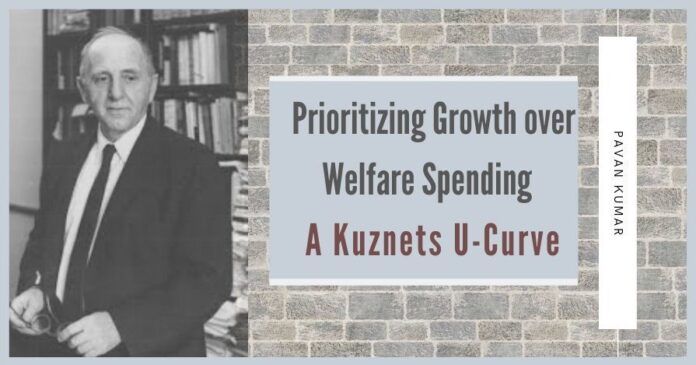
By encouraging enterprise and innovation and prioritizing the overall objective of long-term growth over short-term welfare has its share of boosting an economy’s chances of proving The Kuznets Curve right.
In the late 1950s, Harvard professor and economist, Simon Kuznets came out with an assessment of the relationship between economic growth and economic inequality, using cross-country data available at that time. He opined that the curve took an inverted ‘U’ shape meaning initial rise and later decline. His conclusion was that in the initial stages of development of any economy, inequality would rise due to accumulation of capital in fewer hands and as growth occurred, the living standards would rise to owe to better amenities and cheaper technology thus reducing the inequality gap. This implies the existence of an inherent assumption that the growth would ‘trickle down’ to all sections and thus raise the living standards. It might have applied to the USA, UK, and India of the 1950s but does it, in today’s world of free trade and era of globalization? Is growth still the priority or should inequality be the focus of today’s economic policy?
In the era of free-trade, it is expected that economic inequality reduces and more growth is achieved on account of knowledge and technology transfer from the developed to developing nations. But such a transformation is not fast. A look at Kuznets’ U-shaped Inequality Curve tells the story. The curve appears to hold true in today’s globalization era too as the data available with the World Bank shows that from 1990 to 2011, inequality in India, measured by the Gini coefficient, increased from 0.40 to 0.47. This was supposed to be the period of rapid growth following the reforms of ’91! This simultaneous rise in growth and rise in inequality is analogous to phase 1 of Kuznets’ Inverted U-Curve. A similar trend can be observed in yet another developing country – China. Despite record growth, the Gini data for China shows an average of 0.49 between 2000 and 2010. However, when we look at countries like the United Kingdom and Japan having high per-capita income, the Gini index is in the range of 0.2-0.3 indicating less inequality. This implies, we are now on the other end of the Inverted U-curve predicted by Simon Kuznets. So it holds true on both ends!
Finding the data collection of income distribution to be a huge problem, further studies starting with Paukert began using the Gini Coefficient as a measure of inequality.
Charting Kuznets Curve so as to prioritize objectives can be a difficult task as the relevant variables have to be selected to represent inequality. Historically, it started off with Kuznets undertaking cross country analysis and comparing ratios of income distribution and the GDP levels based on per-capita. Finding the data collection of income distribution to be a huge problem, further studies starting with Paukert began using the Gini Coefficient as a measure of inequality. The coefficient’s value lies between 0 and 1 wherein moving towards 1 implies mean greater inequality.
Coming to the larger question of which is a more important issue to be addressed – Enabling growth or tackling inequality, it is logical and safer to choose growth over the latter. This is because no matter how much investment we pump into welfare projects, the problem will persist as there is no additional factor to move people away from their existing setups and lifestyles. Despite improving welfare, unless there’s a creative disruption, a rapid change cannot occur. Investment in social welfare will aid the elderly and improve healthcare etc. but reduces funds for taking up new projects – innovative and infrastructural, in nature, which can provide much more comfort and welfare into people’s lives. If the USA did not invest in developing home-grown defense technology in the ‘40s, GPS and applications like Uber and Google Maps would not have even been created. The benefits of choosing growth as a primary objective by creating a culture of innovation, allocating adequate funds and encouraging the growth of enterprise are going to last for a long time. Growth creates a condition for a reduction in inequality by entrusting people with something to work for to make their lives better off than they were. This trend too is observed in the later part of Kuznets Inverted U-curve. After a certain level of growth, the benefits of updated technology, newer methods of production and better connectivity begin reaching everyone. This gives people of all classes an incentive to work for something new and earn thus reducing the inequality gap.
The argument that is seldom heard in a discussion on the above issue would be growth as a lopsided priority as it involves a time factor and long terms effects are unpredictable. Suppose we try to improve only growth and neglect the finances involved from various sides, it would imply a huge cost and an unnecessary economic burden. An analogous argument has been found in the case of the Indian Railways – Why bring in bullet trains now; focus should be on improving the existing network and maintain safety, punctuality and cleanliness. That is, rather than going for an altogether new scheme, let us fix the loopholes in the existing set of schemes and work on making them more targeted and monitor the progress post the utilization of the scheme. However, it is more important to have creative disruption and a focus on growth so as to improve the basic living standards from time to time purely driven by innovation. Welfare implies the provision of basic necessities while growth factors in the kind of lifestyle that is in place and products to be produced. Growth is like a general equilibrium effect affecting every section of the society by influencing their behavior and choices and driving them in new directions. It is thus necessary to focus on investment on newer technology and in R&D to successfully lift people out of their routine lives and achieve the right-hand side of Kuznets’ inverted U curve.
Hence, by encouraging enterprise and innovation and prioritizing the overall objective of long-term growth over short-term welfare has its share of boosting an economy’s chances of proving The Kuznets Curve right.
Note:
1. The views expressed here are those of the author and do not necessarily represent or reflect the views of PGurus.
- Ancient to Modern : Exploring the connection between India’s cultural heritage and its modern day economic system. Part 1 - December 25, 2019
- Ancient to Modern: Exploring the connection between India’s cultural heritage and its modern day economic system. Part 2 - December 24, 2019
- Prioritizing Growth over Welfare Spending – A Kuznets U-curveApproach in the Indian Context - December 22, 2019










